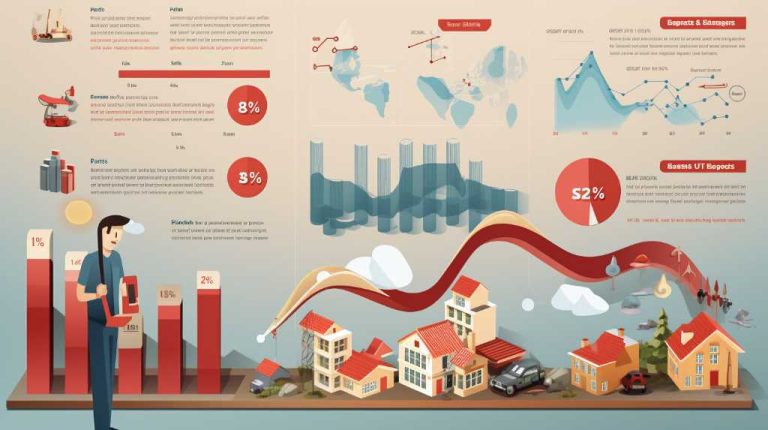Predicting Real Estate Cycles: 12 Powerful Economic Indicators Unveiled

How these Economic Indicators help in Predicting Real Estate Cycles
As they say, knowledge is power, and you’re about to harness it to ride the waves of real estate cycles with confidence.
‘Predicting Real Estate Cycles: 12 Powerful Economic Indicators Unveiled’ is your roadmap to understanding the telltale signs that shape the real estate sector.

You’ll discover how to interpret GDP trends, employment data, and consumer confidence levels to anticipate market shifts.
With insights into housing starts, construction spending, and government policies, you’ll have the freedom to make strategic moves that align with your goals.
Whether you’re investing, buying, or selling, these 12 indicators will empower you to navigate the real estate sector with foresight and agility.
A professional asset management and investment company like ProsperityCRE can help you determine the 12 powerful economic indicators in real estate cycle.
GDP Growth Trends
Your understanding of GDP growth trends, an economic powerhouse, is crucial for anticipating the ebb and flow of real estate cycles. The gross domestic product (GDP) stands as a beacon, illuminating the path of your financial liberation. It’s not just a number—it’s the economic indicator that measures the total value of all goods and services produced, reflecting the might of an economy.

When GDP surges, it often signals a robust market, ripe with opportunities. You can practically feel the energy in the air as construction activity ramps up and housing starts multiply. These are the days when you’re most likely to strike gold in real estate, taking bold steps while the market ascends.
Conversely, a weakening economy casts a shadow on the landscape. GDP trends nose-diving can spell caution, urging you to brace for potential downturns. It’s in these times that you must harness your insight, preparing to navigate the tougher currents. Paying close attention to these fluctuations lets you ride the wave of prosperity and avoid the undertow of a retracting market.
Employment Statistics
Turning your attention to employment statistics, you’ll find that job growth and unemployment trends are pivotal in anticipating real estate market fluctuations.
As you examine the unemployment percentage, consider how shifts in job availability can signal changes in housing demand.

Understanding these employment patterns gives you an edge in predicting which way the real estate winds will blow.
Job Growth Impact
In assessing the future of real estate markets, you’ll find that employment statistics, particularly job growth figures, serve as a critical barometer for economic health and property demand.
As job growth surges, it fuels an expansion phase where freedom and prosperity flourish. You can almost feel the pulse of the economy quicken, bolstering consumer confidence and spending.
This, in turn, energizes the real estate sector, as more people have the means and the optimism to invest in real estate.

Understanding the job growth impact empowers you to anticipate shifts in real estate trends. By keeping an eye on employment trends, you’re better equipped to make informed decisions, positioning yourself to capitalize on the opportunities that arise when the job market thrives.
Unemployment Rate Trends
You’ll find that a single percentage point change in the unemployment rate can significantly influence real estate sector. Unemployment rate trends are a clear reflection of job market conditions, which in turn impact your ability to invest confidently. By keeping an eye on government data, including reports from the Census Bureau, you can gauge the overall health of the economy.
Stable or improving employment statistics suggest more people are earning and can afford to buy or rent homes, driving demand in the real estate sector. Conversely, if unemployment trends upward, it often signals a contraction in the market. Pay attention to these fluctuations; they’re vital for anticipating shifts in real estate, ensuring you maintain the freedom to make timely decisions in your investments.
Housing Starts Data
You’ve seen how employment statistics reflect economic health, but let’s turn your attention to housing starts data, a critical beacon for gauging construction activity.

This data doesn’t just show how many new homes builders are breaking ground on; it’s a robust predictor of market growth, with ripples across the economy.
As you eye the real estate cycles, remember that housing starts offer a window into future consumer spending and overall sector vitality.
Construction Activity Insight
Delving into construction activity, you’ll find that housing starts data offer a predictive glimpse into real estate trends, signaling shifts in economic momentum.
As you explore the health of the real estate sector, consider the number of permits issued. They’re a green light for new residential construction and a telltale sign of market conditions. When permits rise, it’s often a precursor to an uptick in home sales, reflecting a robust demand. Conversely, a drop may hint at a cooling market.

Keeping an eye on these reports, despite their two-month delay, can give you the edge in anticipating changes. They’re not just numbers; they’re the pulse of potential growth, offering you the keys to navigate the waves of real estate with confidence.
Market Growth Predictor
By analyzing housing starts data, you can gain insight into market growth before it becomes apparent to the broader public. This information, supplied by the likes of the Housing and Urban Development and the National Association of Realtors, is crucial.
It’s not just about the numbers; it’s about what they signify. When you see a rise in new construction projects, it indicates builders are betting on future demand—your cue that spending on new construction is set to increase.
These reports, though sometimes delayed, are important economic indicators that savvy individuals like you use to stay ahead. You’re not just following the market—you’re anticipating its moves, ensuring your decisions are informed, strategic, and, most importantly, free from the herd’s late reactions.

Construction Spending
Typically, your assessment of construction spending offers a reliable gauge for anticipating the health of the real estate market. By scrutinizing the Monthly New Residential Construction report, you’re tapping into a rich vein of data. This report, issued by the Department of Housing, is a critical indicator that measures spending on new projects in the United States. It encapsulates building permits, housing starts, and completions, playing a vital role in forecasting consumer behavior.
Spending measures on new construction are influenced by various factors, including mortgage loan rates and the seasons. These elements can either constrain or propel the amount invested in building homes. As you chart your course to financial freedom, understanding these nuances can provide you with a considerable edge.
The report’s lag of two months might seem like a thorn in your side, but it’s a small price for the insights you’ll glean. Remember, construction spending isn’t just another statistic; it’s a beacon that illuminates the early expansion phase of economic activity. Wise investors use this beacon to predict where the real estate market is heading, ensuring they’re not caught off guard when the tides shift.
Consumer Confidence Index
You can gauge the pulse of potential homebuyers’ spending through the Consumer Confidence Index, a crucial predictor of the housing market’s vitality.

Analyzing trends in confidence can help you anticipate shifts in real estate demand.
Understanding the influence of consumer sentiment on the real estate sector is key to predicting its cycles.
Impact on Spending
Monitor the Consumer Confidence Index closely, as it directly influences your spending decisions and, ultimately, the real estate market’s vitality. This economic barometer can signal when you’re likely to open your wallet wider or tighten the purse strings.
When confidence soars, spending is an economic powerhouse, fueling growth and energizing the housing sector. On the flip side, a dip in confidence can presage a pullback in expenditure, cooling the market.

Stay ahead of the curve by keeping an eye on this Index. It’s a critical piece of the financial puzzle, offering foresight that’s invaluable. Read the Financial Review, and you’ll see analysts pore over CCI numbers for a reason. They understand that your confidence today outlines tomorrow’s economic landscape.
Confidence Trends Analysis
While you assess the Consumer Confidence Index to gauge spending habits, it’s also crucial to analyze its trends for insights into the real estate market’s future movements. This index is one of the main indicators that can guide your financial planning, offering a glimpse into the potential rise or fall in property demand.
As you value your independence, understanding the Monthly Report of the CCI empowers you to anticipate changes in the market before they occur. It’s a strategic move to consider how shifts in consumer confidence, often influenced by fluctuating interest rates, correlate with real estate cycles.
Housing Market Influence
Understanding the Consumer Confidence Index helps you predict the ebb and flow of the housing market with greater accuracy. This financial barometer, gauging the optimism or pessimism of consumers, directly influences your freedom to make savvy investment decisions. When confidence soars, people are more likely to buy homes, sparking activity in the market.

Dive into original reporting and tap into primary sources to support your strategies. Remember, indicators are economic forecasts, not certainties. But by blending CCI insights with research from other reputable analysts, you’ll navigate the seas of real estate with confidence.
It’s about harnessing knowledge that empowers you to act when the time is ripe, ensuring your real estate ventures are as liberated as your ambitions.
Mortgage Rate Fluctuations
You’ll notice that shifts in mortgage rates are pivotal in gauging the real estate market’s health. These mortgage rate fluctuations can be your compass in navigating the complex terrain of the market. As Investopedia suggests, understanding how these rates change gives you the power to make informed decisions—whether you’re aiming to buy a new home or invest in property.
The Federal Reserve plays a significant role in influencing interest rates, which directly impact mortgage rates. When the Fed adjusts rates, it sends ripples across the market. You can almost feel the pulse of the economy’s heartbeat through these changes. A hike in rates might cool down a heated market, granting you more freedom to choose without the pressure of sky-high prices. On the flip side, lower interest rates can unlock doors to homeownership that seemed closed before.

In essence, keeping a keen eye on mortgage rate trends lets you ride the wave of the market rather than being swept away by it. Whether you’re a seasoned investor or a first-time buyer, these indicators are your toolkit for economic liberty in the real estate world. So, embrace the fluctuations—they’re not just numbers, they’re signals to your next opportunity.
Rental Vacancy Rates
Many rental vacancy rates can serve as a barometer for the real estate market’s vitality, giving you insights into potential shifts and trends. When you’re analyzing site usage and scouting for opportunities, it’s crucial to keep an eye on these figures.
Low rental vacancy rates usually signal a landlord’s market, where demand is outpacing supply, and the real estate cycle may be on an upward trajectory. Conversely, if you’re noticing a creeping increase in unoccupied rentals, brace yourself—this may hint at an oversupply that could dampen property values and rent prices.
To get a deeper understanding, look beyond the raw numbers. Dive into reports from the Reserve Bank of St. Louis or seek out interviews with industry experts. These sources can provide context for changes in rental vacancy rates, helping you to distinguish between temporary fluctuations and the onset of more significant market adjustments.

Remember, your financial independence hinges on the ability to anticipate market movements. By tracking rental vacancy rates and interpreting what they imply for real estate cycles, you’ll be better equipped to make informed decisions, whether you’re investing in properties, looking to rent, or planning to sell.
Stay vigilant and let these indicators steer your strategy towards success.
Credit Availability
As you assess the real estate sector, consider how credit availability acts as a predictive tool for upcoming cycles. It’s a clear-cut economic indicator that can signal when you’ve got more, or less, freedom to make bold moves in property investments. When lenders open the tap, offering loans with fewer restrictions, it’s a sign that the market is on an upswing. You’ll see a rise in consumer spending and a surge in real estate investments.
On the flip side, when credit tightens up, it’s a heads-up that the market might be heading for a cooler phase. This could be your cue to tread carefully or strategize for long-term holdings rather than quick flips. By keeping an eye on trends in credit availability, you’re arming yourself with knowledge that can help you anticipate shifts in real estate cycles.

Dive into resources like Investopedia or other reputable publishers for deeper insights into the current lending climate. Remember, the real estate sector waits for no one, and being ahead of the curve on credit trends could be your ticket to capitalizing on the next big opportunity—or steering clear of a downturn.
Retail Sales Figures
Retail sales figures, an essential barometer of consumer expenditure, can directly influence your real estate investment decisions. These figures don’t just reflect what’s happening now; they’re a crystal ball into upcoming real estate cycles. When consumers are opening their wallets wide, it’s often a sign that the economy’s in an expansion phase—which can mean a bustling real estate sector is on the horizon.
You’re not just buying property; you’re betting on the economic climate. Rising retail sales figures suggest that people feel confident about their financial stability, hinting that they might be ready to take on mortgages and invest in real estate. Conversely, a dip might signal caution, a potential slowdown in the real estate market.
Keep in mind, though, that these economic indicators, including retail sales figures, are influenced by various factors like mortgage loan rates and seasonal changes. They’re part of a bigger picture.

As Investopedia receives compensation for featured placements, you can count on us for unbiased content in our editorial, guiding you toward making informed decisions. So, harness the predictive power of retail sales figures to time your real estate ventures, and you’ll be one step ahead in the game of financial freedom.
Stock Market Performance
While retail sales figures give you a glimpse into consumer confidence, stock market performance offers a broader perspective on investor sentiment, which can significantly impact real estate trends. As you navigate the landscape of economic indicators, understanding the ebb and flow of the stock market provides valuable insights that can guide your decisions, especially when it comes to real estate cycles.
Market indexes, which encompass stocks, bonds, and commodities, are the pulse of the financial world. They don’t just reveal the current state; they’re a crystal ball, albeit a short-term one, hinting at future economic shifts. When you see the stock market rallying, it often means investors are bullish, mutual funds are thriving, and the ripple effects can buoy the real estate market. Conversely, a downturn suggests caution, which could lead to a cooling property market.
Keep an eye on these indexes; they’re not just numbers. They encapsulate the collective actions and sentiments of investors. When the pound soars against the dollar, or when stock futures point upwards, you’re witnessing the gears of economic change in motion. These movements are your cues, empowering you with the foresight to anticipate and act on real estate cycles with confidence.

Demographic Shifts
You’ll find that demographic shifts are critical to anticipating real estate market trends and cycles. As an investor, you’re not just buying property; you’re strategically placing your bets on the ebbs and flows of human movement and age-related changes.
Population growth, for instance, isn’t just a number—it’s a wave of demand for homes, especially as more young adults strike out on their own, looking for starter homes or rental properties to call their own.
On the flip side, as the population ages, you might see a surge in the need for senior housing and retirement communities. This isn’t guesswork; it’s strategic planning based on predictive economic indicators.
Migration patterns also play a massive role. Whether it’s the draw of urban life or the appeal of spacious suburbs, where people move shapes the market in real-time.

Your original research into these shifts can set you apart, allowing you to anticipate where the next hot market will be or where the current one may cool down. Understanding these demographic trends gives you the freedom to make informed choices, ensuring your investments stay ahead of the curve in the ever-changing real estate cycles.
Government Policy Impacts
Government policies directly shape the landscape of your real estate investments, influencing key economic indicators that signal upcoming market shifts. When the FOMC hints at interest rate changes, you’re looking at a potential ripple effect on mortgage rates, affecting how hot or cold the market gets. Staying ahead means keeping an eye on the Beige Book for clues on government policy impacts and using that insight to anticipate real estate cycles.
Tax incentives can either spur or slow down your ventures. They’re like a beacon for where money flows, shining a light on hot spots for development and investment. You’ll want to track these changes meticulously; they could make or break the profitability of your next move.
Your freedom to invest wisely hinges on understanding how government actions influence economic indicators. Reports like the Manufacturing Business Outlook Survey and Durable Goods Report are barometers of the manufacturing sector’s health, which ties back to the demand for commercial real estate.

Stay informed, review our updated Terms on Investopedia, and interpret these economic indicators as signals. They’re the compass by which you’ll navigate the ever-changing tides of the real estate market, ensuring you’re always a step ahead in the game.
Also, check our related blog: Apartment Market Analysis: 5 Key Trends And Rental Market Research
Frequently Asked Questions
What Is the Lei Leading Indicator?
The LEI leading indicator helps you anticipate economic shifts by analyzing housing starts, consumer confidence, credit markets, construction spending, and job market strength, empowering you to make informed decisions with financial freedom.
What Is the Current Lei?
You can’t predict market fluctuations or demographic shifts, but the current LEI informs your investment strategies. Zoning laws and interest rates impact it, so stay alert to navigate your financial freedom wisely.
Which Economic Indicator Is Most Useful for Predicting Future Economic Trends?
You’re steering through economic forecasts, searching for the North Star. Housing starts, with their pulse on consumer spending, often shine brightest in predicting future trends, followed closely by job reports and consumer confidence.
What Is the ECRI Leading Index?
The ECRI Leading Index gauges global economic impact and consumer confidence, signaling recession warning signs and influencing your investment strategies amid housing market dynamics. It’s crucial for maintaining your financial freedom.
Conclusion
You’ve journeyed through a landscape of indicators, each a piece of the real estate puzzle. As GDP climbs and shovels break ground, you sense market rhythms.
Jobs reports and sales receipts whisper of boom or bust. Stocks and consumer spirits sway your intuition. Amidst policy winds and demographic tides, your insight deepens.
Now, you stand at the cusp of prediction, poised to catch the cycle’s wave. Go forth, navigate with confidence; the market’s secrets are yours.








3 Comments
Comments are closed.